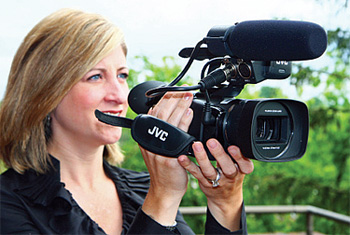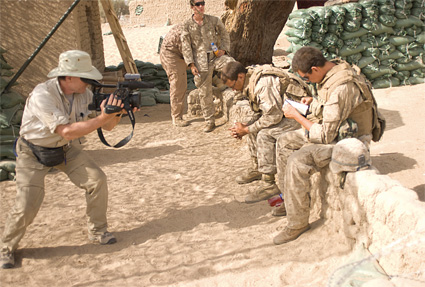The Incredible Shrinking News Camera
SEATTLE—Psssst: small handheld and palm sized camcorders are making their way into newsrooms and out onto the streets with electronic journalists. Not all that long ago, the thinking went that such a thing could never happen.
"If you'd asked me 10 years ago," admitted Bob Ott, Sony Electronics vice president of product marketing and management, "from a durability standpoint, from a picture standpoint, from every other standpoint, you've got to stay with the shoulder-mounted camcorder."

Hearst station WLWT-TV uses JVC’s compact GY-HM100 ProHD camcorder The thought that broadcast quality cameras could get so small they could fit in a pocket, just as camera makers were working to produce affordable HD camcorders that wouldn't break the bank or the cameraman's back… such small HD camcorders were not on the industry's radar.
Today, they're definitely arriving in TV stations, and going out to cover the news.
CONSUMER? PROSUMER?
Industry experts say that to a great degree, it's not the size of the camcorder, it's the capabilities and features it has. And they agree about something else: you're not going to get those features on a consumer grade camera.
"A consumer camera? No way," said Jan Crittenden, product manager at Panasonic. "It wouldn't pass the ruggedability test, wouldn't have the manual overrides that most professional photographers would want to have, those sorts of things. You're working with camera operators who know how to run a camera, and you don't want to force them to use the features consumers do."
Dave Walton, assistant vice president of marketing and communications for JVC, echoed Crittenden's comments. "If you're looking at those small consumer type camcorders, or even the iPhone type products, then I'd say you'd have those limitations."
But Walton said on JVC's and other manufacturers' small but professional camcorders, "you have manual lens control, you have gain and whitebalance, you have XLR audio connectors, and audio gain control."
Like the others manufacturers TV Technology spoke with, Larry Thorpe, national sales executive for Canon, said they're continuing to sell larger, shoulder mount camcorders. "If it's hard news coverage, they go out with a traditional shoulder mount camera. Maybe if it's investigative coverage, or working in a more confined space, the smaller or tiny camcorder may make more sense."
Ikegami ENG Specialist Bob Molczan pointed to all the accessories and capabilities cameramen have gotten used to in larger camcorders. "The ability to change lenses, use four audio channels, and to mount wireless microwave transmitters, even to mount lights, those are things you can only do with larger camcorders."
Though its shoulder mount cameras are smaller than their predecessors, Molczan said Ikegami has not chosen to go down the small camcorder path, instead, staying with 2/3-inch 3-CCD imager shoulder-mount models. "We still target the niche market, where high quality images and durability are what the customers are looking for."
WAR CONNECTION

Backpack journalist Bill Gentile shoots video of troops of the 24th Marine Expeditionary Unit, which was deployed to Afghanistan’s southern Helmand Province along the border with Pakistan. Still, there are a growing number of news operations that are going to the small camcorders, including the iPhone, and cost may be part of the reason. "If I've got a large number of people shooting news at a station now, and a full size camcorder costs something like 11 grand apiece, you can get some of the smaller cameras for under 5-grand," Crittenden said.
JVC's Walton said it's also reflective of a change overall in field news operations. "Now you often find a single reporter/cameraman go out on stories, and he's got not only the camera and tripod to carry, but his laptop, and he can't carry along a shoulder-mount camera."
One of the technological advances that has made design of small form-factor cameras possible has been the development of high capacity, and affordable, solid-state media. Not only is the media itself small, but there's no need to build in tape threading mechanisms, motors and scanners.
"We're seeing tremendous developments that have taken place in camcorders," said Canon's Thorpe, "to give a broad range in price and performance." And where at one time a station had to stick with a single recording codec to move video material through the editing process, "modern editors have become more flexible and codec-agile," he said.
So how did these small and even tiny camcorders sneak into electronic journalism? There's general agreement that they're a dividend from the U.S.'s involvement in the Middle East wars, and the embedding of journalists with combat troops.
Though earlier versions of the small sized camcorders may not have been up to snuff, picture quality-wise, "the smaller camcorders were easier to pack around, less obtrusive, and made you a smaller target," said Walton.
They were also expendable said Sony's Ott. "This is good because in that situation, I'm in an environment where, quite honestly, I'll pull the plug and lay the camera down to save my life."
Today, footage coming out of the wars from the small camcorders looks more on par with video shot with full-sized camcorders under much less hostile conditions.
Crittenden pointed out that for some long-time news photographers, there could be an attitude that gets in the way. "You have to take into account whether they're going to go out and shoot trashy footage and blame it on the camera, or whether they're going to make a whole-hearted effort to come back with good stuff."
Completing that thought about the size and complexity of the legacy, shoulder mounted camcorders, Ott said, "There are any number of reasons to stay with a large sized camera, including the fact that they tend to impress people."
The professional video industry's #1 source for news, trends and product and tech information. Sign up below.
